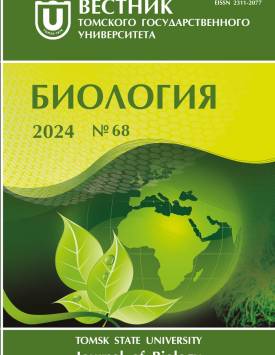Brown bears marking behavior and its seasonality in the Russian Far East
Marking behavior is playing an important role in indirect communication of animals, which performs a number of functions at the population level, including distribution of individuals in space, interaction of sexual partners, establishment of a group hierarchy, decreasing the likelihood of direct encounters between competing individuals, and affects animals movement and home ranges use. Brown bears (Ursus arctos L.) through the marking activity leave marks on trees (rubbing, debarking and bites), pedal marks on the ground (holes made by rotational movements of the limbs) and urinate. Knowledge of animals social behavior and understanding of their communication systems is useful to specialists in the brown bear populations management. Studies were carried out in two regions of the Russian Far East: in the Middle Sikhote-Alin (44°50'-45°55N, 136°01'-137°37'E.) and in Eastern Sakhalin (50°36'-50°37N, 143°41'-143°42'E). We used photo and video recording with camera traps next to 32 marking trees in Sikhote-Alin in 2013-2020 and three trees on Sakhalin in 20112012 to study brown bears marking behavior (Bushnell Trophy Cam HD, Reconyx PC900, and Seelock Spromise S308) during the non-denning period for animals (March-November). For each bears pass we collected information about date, age and sex of individuals (when it was possible to determine), the number of individuals in the group and its composition; we also described the behavior with the chronology and duration of individual acts of marking activity. We distinguished following acts of bears behavior: passing by a tree without sniffing and marking it, sniffing the trunk or soil under the tree, rubbing on the trunk, biting and debarking, pedal marking, and urinating. In the Middle Sikhote-Alin we collected information during 3562 trap-days and registered 117 brown bears passes. In Eastern Sakhalin we recorded 245 passes of brown bears over 539 trap-days (See Table 1). Bears receive information from marking objects through sniffing. We observed sniffing of marking objects by bears 167 times. Animals sniffed the trunk more often (in 92.0 and 82.5% of cases in Sikhote-Alin and Sakhalin, respectively), and not so often - the soil under the tree. An average duration of trunk sniffing for bears in two regions was 2.8-8.0 sec, with a maximum of 51 sec (See Table 2, 3). Bears sniffed the trunk, mostly standing on four legs, less often while standing on their hind legs, leaning with their front legs against a tree. Animals sniffed both the trunk and the soil below, since the smell is located on the tree itself (remains after rubbing) and under it (the result of urination and pedal-marking). Marking behavior of bears was registered 79 times. In all cases animals were rubbing against the trunk. In addition, in Sikhote-Alin, in 5.9% of cases, the bears were biting the bark, in 3.9% they the debarking a tree with their claws, in at least 9.8% they performed urination, and in at least 5.9% they left pedal marks. At least twice on Sakhalin bears urinated and at least twice they left pedal marks. In average bears were staying near a tree during marking for 39.0 sec (max = 151 sec) in Sikhote-Alin and for 15.4 sec (max = 37 sec) in Sakhalin. The longest bear rubbing on a tree lasted 54 seconds (See Table 2). Most often animals rubbed their backs, necks, and heads against the trunk, standing on their hind legs with their backs to the tree (See Fig. 1). Less often, bears rubbed their sides and necks on the trunk, standing on four legs. The rubbing contains information about the individual smell of the bear. The characteristic posture during rubbing is explained by the presence of glands on the back of the brown bears body, the secrets of which are applied to the tree. Debarking, bites, pedal marks and urine marking are less common but significant signal signs left by bears and acting on the visual, olfactory and tactile analyzers of their relatives. Marking activity is typical for all sex and age groups of bears, including cubs of the first year of life. However, most of the marking behavior observed in adult males, which is similar to the observations of bears in other regions. Females and juveniles most often rub on trees after sniffing. Urination was observed for animals of both sexes, in contrast to the trunk biting, debarking, and pedal marking, which were recorded only for adult males. Bears are characterized by individual features of the marking repertoire. The marking behavior of brown bears in the study area observed during the entire non-denning period, but more often from May to August. Thus, the exacerbation of social activity through signal marking in bears occurs during the mating season in the Russian Far East, as well as in other regions. Communications through marking during the rutting period can influence the process of reproduction, allow animals to meet a sexual partner, and contribute to the participation of the healthiest and strongest males in mating. This explains the similar seasonal trends for bears in marking behavior in both study regions (See Fig. 2). An exacerbation of bears marking activity was also observed during hyperphagia by salmon in spawning grounds, which is associated with the indirect interaction of animals in places of their concentration and the establishment of a hierarchy in temporary groups. The paper contains 2 Figures, 3 Tables, 33 References. The Authors declare no conflict of interest.
Keywords
marking activity, marking tree, signal marking, intraspecific relations, animal behavior, Ursus arctosAuthors
| Name | Organization | |
| Seryodkin Ivan V. | Pacific Geographical Institute, Far Eastern Branch of the Russian Academy of Science | seryodkinivan@inbox.ru |
| Petrunenko Yury K. | Pacific Geographical Institute, Far Eastern Branch of the Russian Academy of Science | yurbarius@gmail.com |
| Soutyrina Svetlana V. | Sikhote-Alin State Reserve | sikhote-boss@mail.ru |
References

Brown bears marking behavior and its seasonality in the Russian Far East | Vestnik Tomskogo gosudarstvennogo universiteta. Biologiya - Tomsk State University Journal of Biology. 2024. № 68. DOI: 10.17223/19988591/68/6
